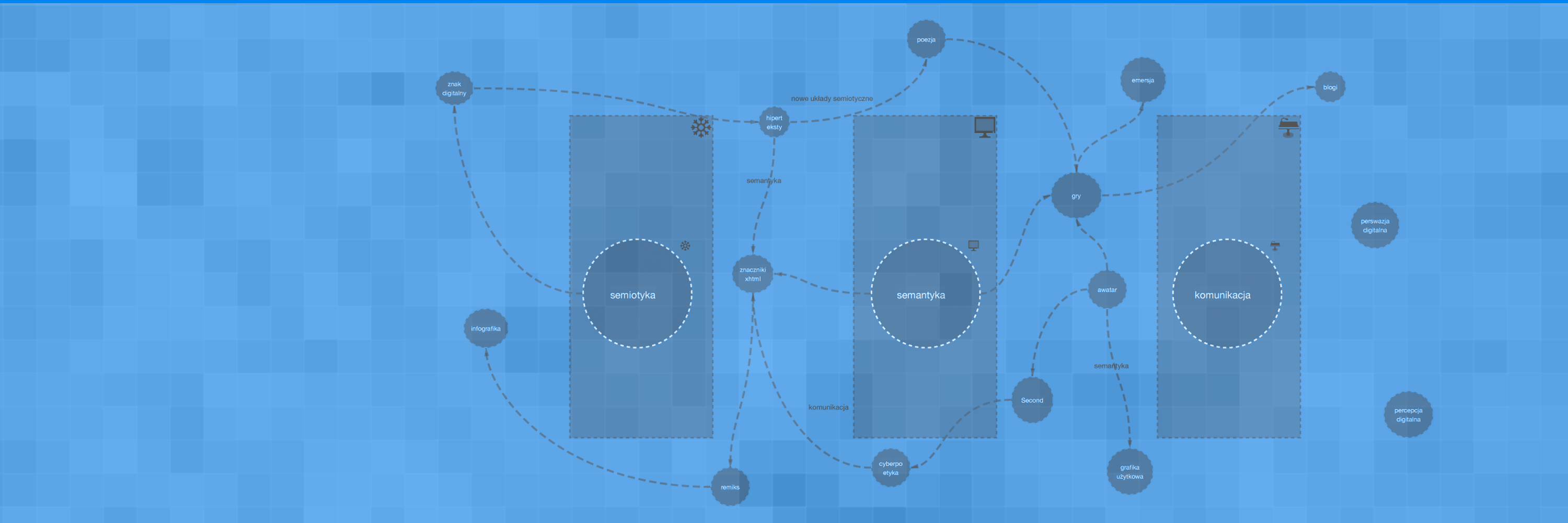
N N103 398340; Structure of digital transmission – semiotic, semantic and communication aspects; Warsaw University, the Faculty of Polish Studies.
The study of semiotic aspects of a digital transmission has brought a new concept of a sign (Szczęsna ). It has been found that the digital sign is a two-level structure (level of programming and a level of usage) and has multi aspect nature (aspect of representations, meanings, actions – mediation and operational ones, meta aspect). At the level of usage it's specificity is decided by the aspect of actions (mediation signs and operatioanal signs has been distinguished), at the level of programming – meta aspect, that is defining the sign at the level of usage (organizers, modifier and semantics has been distinguished)
Semiotic model of hyperlink has been developed(Pisarski ) based on a Hjemslev's model (substance – form / expression – content) complemented by the aspect of action (expression –content – action), and Tina Schneider's semiotic research of hyperlink.
Research of symbolic signs on the Internet (Kaźmierczak ) has brought the definition of their specificity and demonstration of the adaptation, modification processes as well as its transfer to the discourse of everyday life.
Analysis of the user interface on the material of computer games resulted in the discovery of emersion (and the description of the emmersive factors) – text mechanisms that stand as opposition to immersion, and which nature is the exposition of the mediated mode of participation in the simulated digital enviorment (Kubiński ).
The category of cybersemioticity has been introduced (Pawlicka ), which defines the specificity of semiotic organization of digital enviorment on the example of semiotic organization of digital literature. Image-verbal forms on the web pages have been described (Smaga ).
The work on the semantics of digital transmission is enabled by the characteristics of infographic sign, which underlines the semantics of digital text (Smaga ). Next, the studies have been developed around the semantic strategies in art (digital literature especially). It has been stated that the layer of representations (texture) is subjected to the additional semantization and textualization. The meaning is created in the interaction of mobile semantics, polisemantic structure, semantic of word, and semantics of user actions (Szczęsna ) that causes the appearance of new kinetic figures, interactive figures (cumulation, atomization, reduction, adjection, permutation) and digital reinterpretation of already existing: kinetic metaphors, interactive metaphors (Szczęsna ).
The studies of digital narration has resulted in specification and characteristics of various types of hypertext plots and hypertext capacity of literary narrative structures in the space of traditional literary media (Pisarski ); hypertext has been examined as a tool and a semantic system, as a structure and a form reinforcing the content at the same time (Pawlicka ). Studies led to description of procedures of a personal experience textualization on the example of intimacy (Kaźmierczak ).
The studies of digital communication has led to characteristics of functions and forms of user activity, whose communication activities depend on the net infrastructure (Kaźmierczak ), the description of a phenomenon of automatic intertextuality (based on the linking) and shaped by the link organization of transmissions and the increasing hybridization of textual forms (Szwechłowicz)and characteristics of a digital transmission forms (Szczęsna, Pisarski, Pawlicka ) with a particular emphasis on network adaptation and translation process (translator's actions) at the visual layer, interface layer, layer of code and between the codes.
The study of digital literature have brought the reflection on its literary nature (Pawlicka ). Stwierdzono, że brak stałych wyznaczników literackości sprawia, że rozstrzygniecie o niej odbywa się tu w przestrzeni komunikacyjnej między twórcą, użytkownikiem i utworem cyfrowym.
Analizy perswazji digitalnej, przeprowadzone na materiale publicystycznych gier wideo It has been stated that the lack of permanent indicators of literacy makes the conclusion happen in communication between a creator, a user, and a digital work. Analysis of digital persuasion performed on the matter of publicist video games (Kubiński ) and educational platforms (Szczęsna ) have shown that persuasion has mediated nature – it is realized throught the angaging and participation: in game, quizzes, forums, educational tasks. text by Ewa Szczęsna, translation by Marek Ostrowski
Prof. dr hab. Ewa Szczęsna, dr Agnieszka Smaga, mgr Urszula Pawlicka, dr Marek Kazimierczak, dr Piotr Kubiński, dr Mariusz Pisarski.
Pracownia Badań Intersemiotycznych i Intermedialnych Uniwersytetu Warszawskiego.